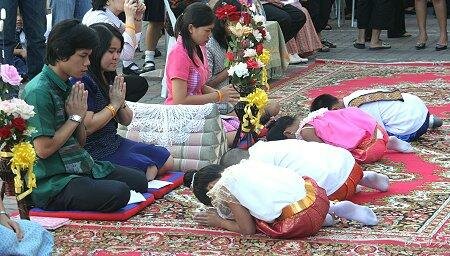The Thai Wai and Foreign Tourists
A slight bow, palms raised together – when and how exactly does one do this in Thailand?

At school last week, we held our regular Thai Manners competition for the students. The students wore traditional Thai clothes and had to visit a number of different bases in order to show that they knew how to perform the proper respect in the correct manner. This reminded me of one of the most common questions that we get in our mailbox. That is the Thai Wai. How to use it and when to use it.
For those of you who don’t know yet, a Thai Wai is a prayer like gesture done by bringing your hands together at about nose level. Adults use it to greet each other and also to bid farewell. It shouldn’t be confused with the Western handshake. Personally I would only shake hands with someone I was meeting for the first time or that I haven’t seen for a long while. People wai each other on a daily basis. Children will wai their parents when they leave home to go to school. When they come home they will wai again. Adults arriving at work will wai their colleagues and their bosses in the workplace.
The wai can also be used in other ways. For example, to say sorry. If you step on someone’s toes, you could wai them to ask forgiveness. You do that if you know you have done something really wrong. An alternative is to bow your head. Not as much as the Japanese do. It is more like a deep nod. Another use for the wai is to say “thank you”. If someone gave me a present or did a big favour that I was really grateful for, I would then wai them. An alternative is the bow for minor favours. For example, if you are waiting in your car to turn left and someone lets you out then you can give them a head bow. Actually, I call it the “chicken bow” as you move your head forward as you bow, much like a chicken does.
Another use of the wai is to show respect. If my students want to come back into the classroom after visiting the toilet, they will stand in the doorway, give a wai and ask permission to enter. If they want to excuse themselves, they have to do the same. Before exam time, my students like me to wish them good luck. This is a bit like giving them a blessing. To receive this they should give a wai while I am blessing them. People also do this at the temple when speaking to a monk or listening to a sermon. When I have finished they will run their fingers through their hair in order to seal in the good luck.
If you decide to do a wai, please do it in a graceful manner. It should always be done slowly and with feeling.
As you have seen, there are different reasons for giving a wai. To make it more confusing, there are also different levels of the wai. You should also remember who has to wai first. For example, as a rule, we don’t normally wai the students at school. You certainly mustn’t wai a child first as this is considered bad luck for them. The only students I would wai are my ex-students who have come back to visit. If you want to wai back to a child, then you can just use the “receiving wai” which you can see in the top picture. For this you bring your hands to about chest level.
For everyday wais I would suggest foreigners to use what I call the “lazy wai”. This is bringing your hands to your head so that the tip of your thumbs touch the base of your nose. You can use this wai with people of equal position or with service people. However, you should remember that you shouldn’t wai service workers first. To show the proper respect, you should allow them to wai you first. As a general rule, if an adult gives you a wai then please make sure you wai them back. However, you might see some people just giving the “chicken nod” to their servants in return.
For someone important (basically anyone older than you or your boss) you should give them the proper wai. To do this, bring your hands together in front of you to about chest level and then bow your head down to meet them. This is showing more respect. Women can do a little dip by bending their knees to show respect. The lower they dip the more respect they are showing. If you want to show a lot of respect, like to your mother on Mother’s Day, you can get on your knees and bow down right to her feet.
The final question is, should foreign tourists wai anyone? I would say that as a tourist they shouldn’t wai someone first. Unless of course you need to make a good impression with someone. Like I said before, if an adult wais you first then you should wai them back. However, you don’t have to do this to the cashier at 7-Eleven or the supermarket. There is no need. Just smile and give the “chicken nod”. When you go to a restaurant, you will be greeted by the waitress. Again, you are only obliged to give a smile and nod. It is up to you if you want to wai them back. When you leave they will wai you again. Personally I would only wai them in return if we had some kind of friendly conversation during the meal.
If you decide to do a wai, please do it in a graceful manner. It should always be done slowly and with feeling.
This post was originally published in Thai Culture Blogs in December 2010.

















